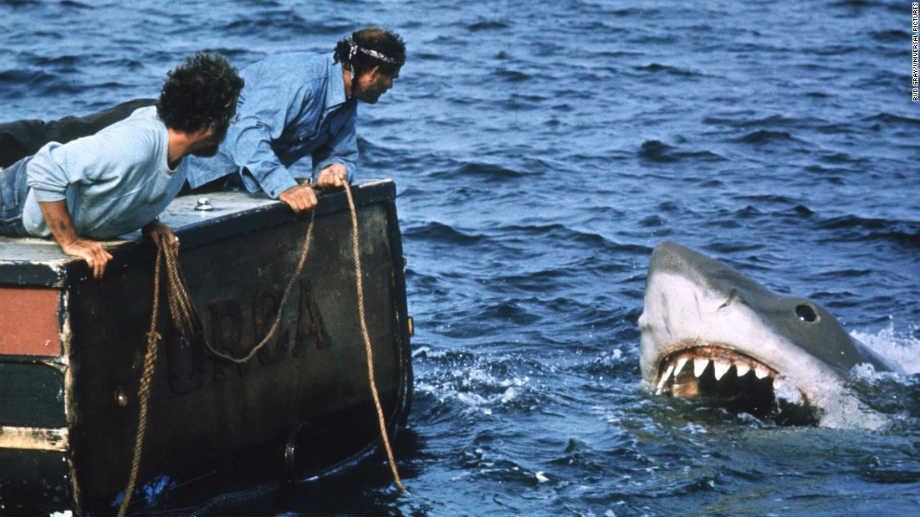21 random facts about 'Jaws'

(CNN) -- It should have been a waterlogged disaster.
The shoot ran too long and over budget, the script was still being written as scenes were filmed, the young director woke up every day fearing he would get fired and the mechanical shark built for the movie sank to the bottom of the ocean.
And yet, 40 years ago this summer, people lined up around the block and around the world to get scared silly by \"Jaws,\" widely seen as the first summer blockbuster.
A horror story wrapped in an adventure, the movie tapped into our deepest fears about what dangers lurk beneath the ocean's surface. Some people told screenwriter Carl Gottlieb the movie, about a giant shark terrorizing a summer resort town, even made them afraid to venture into swimming pools.
Yes, the fake shark looks a little cheesy now. But in 1975, long before computers could create any spectacle onscreen, it was plenty terrifying.
The movie overcame a troubled shoot to launch Steven Spielberg's career as a master craftsman of popular entertainments. With its wide release and aggressive ad campaign, it also pioneered the current Hollywood model for how big-budget movies are springboarded into the market.
And it sparked a cultural fascination with sharks -- especially great whites -- that endures today in everything from IMAX documentaries to the \"Sharknado\" movies to the Discovery Channel's annual Shark Week.
The original \"Jaws\" will return to select theaters nationwide on June 21 and 24, giving today's moviegoers a rare chance to see it on the big screen. Which means that 40 years later, it's still not safe to go back in the water.
Here's a roundup of 21 salient and strange facts about the movie.
1. Spielberg, whose first film \"Duel\" was about a highway motorist being menaced by a mysterious tanker truck, was afraid of being typecast if he took the \"Jaws\" job. \"Who wants to be known as a shark-and-truck director?\" he complained.
2. None of the three main actors -- Roy Scheider, Robert Shaw and Richard Dreyfuss -- was the producers' first choice for the parts. Robert Duvall and Charlton Heston were among those considered for Chief Brody, while Lee Marvin and Sterling Hayden were initially sought for Captain Quint and Jeff Bridges was discussed for Matt Hooper, the marine biologist.
3. The movie's script eliminated several subplots from Peter Benchley's novel that Spielberg considered distracting, including an affair between Chief Brody's wife, Ellen, and Hooper (Dreyfuss).
4. Location scouts considered filming locales around the United States but chose Martha's Vineyard because they needed a summer beach resort town with a sheltered bay, manageable tides and shallow waters to make filming easier.
5. Although the movie is set in midsummer, producers began filming in early May 1974 to avoid an actors' strike that was scheduled to begin July 1. If you look closely in the background of some scenes you can see trees with no leaves.
6. The movie's 25-foot great white shark was played by three full-scale mechanical models towed by submerged \"sleds\" or guided by hidden scuba divers. The crew nicknamed the shark \"Bruce\" after Spielberg's lawyer, Bruce Ramer.
7. Spielberg, frustrated by the shark's frequent malfunctions, had another name for it: \"the great white turd.\"
8. The British actor Shaw was so concerned about owing taxes to the IRS on his income that he flew to Bermuda or Canada on almost all his days off to limit his work hours in the United States.
9. The grieving mother who slapped Chief Brody in the movie was played by actress Lee Fierro. She had a difficult time faking the slap and instead walloped Scheider over and over during the many takes needed to get the scene right.
10. At one point Quint's boat, the Orca, sank unexpectedly during filming, soaking cameras and threatening to ruin the day's completed footage. The waterlogged film was flown to a lab in New York, where technicians were able to save it.
11. When composer John Williams first played his ominous two-note \"shark theme\" score for Spielberg on a piano, the director thought it was a joke. Later Spielberg would say, \"The score was clearly responsible for half of the success of that movie.\"
12. Local fishermen were unable to catch a big enough shark to use in the scene where town officials prematurely celebrate a large shark that's been caught and strung up on a dock. So the film's producers located a freshly caught 13-foot tiger shark in Florida and flew it up to Massachusetts on a private plane. By the time the cameras rolled, however, the shark was decomposing and smelled awful.
13. The movie's protracted shoot was so troubled by mishaps that some crew members privately began calling the film \"Flaws.\"
14. Brody's famous line upon first encountering the shark, \"We're gonna need a bigger boat,\" was ad-libbed by Scheider. At test screenings the audience's screams drowned out the line, so Spielberg re-edited the scene to make it more audible.
15. A young filmmaker named John Landis was visiting the set when he was pressed into duty to help build the rickety wooden pier used in the scene where two men try to catch the shark with a hook and chain, baited with a roast. Landis went on to direct \"Animal House\" and \"An American Werewolf in London.\"
16. For the famous scene in which Quint recounts the sinking of the USS Indianapolis, Shaw persuaded Spielberg to let him have a few drinks before the cameras started rolling. But Shaw got so drunk he had to be carried to the set and couldn't get through his lines. He later called Spielberg and apologized; they shot the scene again the next day and Shaw nailed it.
17. To add authenticity to the scene where Hooper goes underwater in the shark cage, a second unit shot footage of real sharks in Australia. To make the sharks appear bigger, the filmmakers used a shrunken shark cage and a Hooper stunt double played by a 4-foot-9 ex-jockey in a wetsuit.
18. The original script, like the novel, called for Hooper to be killed when the shark bites through the cage. But the Australia crew had captured spectacular footage of a great white attacking an empty shark cage, and Spielberg wanted to use it. So the scene was rewritten to let Hooper escape, sparing Dreyfuss' character.
19. After principal filming wrapped, Spielberg decided he needed one more big scare. He wasn't satisfied with the scene where Hooper investigates a fisherman's sunken boat and is jolted when the man's disembodied head floats out of the hull. So Spielberg recruited a small crew and reshot the scene in film editor Verna Fields' backyard swimming pool in Encino, California. To make the clear, chlorinated water match the murkier look of the ocean, crew members poured a gallon of milk into the pool.
20. Test screenings revealed the audience's loudest screams were for the severed-head scene -- even louder than when the shark first rises out of the water behind Brody. After the movie opened, Spielberg and screenwriter Gottlieb would sneak into screenings in Los Angeles and stand in the back of the theater \"just to watch the sold-out audience visibly rise out of their seats with a collective shriek.\"
21. John Williams conducted the orchestra during the 1976 Academy Awards, so when he won the Oscar for best score he had to dash up to the podium to accept his Oscar and then run back down to continue conducting.
Sources: \"The Jaws Log,\" by Carl Gottlieb; Ain't it Cool News; IMDb.
